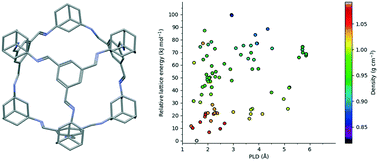Computational discovery of a large-imine-cage-based porous molecular material and its application in water desalination†
Abstract
Porous molecular materials based on imine cages are prototyped for applications such as gas separations, water purification and others. Among tens of imine cages that have been synthesized so far, ones supporting large pore materials for high-flux membrane applications are rare due to the natural tendency of atoms and molecules to favor high-density arrangements. Here, we present a computational approach leading to identification of a large rigid imine cage molecule, which is based on 1,3,5-triformylbenzene and adamantane-1,3-diamine precursors. Through density functional theory-based crystal structure prediction, we demonstrate that this cage supports a number of synthetically-accessible porous crystal phases characterized by pore limiting diameters in the range of 3.5–5.5 Å. Furthermore, we demonstrate that the new cage molecule also supports a highly porous amorphous phase enabling a high-flux reverse-osmosis membrane application. Our molecular simulation-based investigation of the latter membrane in a water desalination scenario suggests that the new material can offer more than 100% increase in water flux over the benchmark porous Covalent Cage 3 (CC3) material.



 Please wait while we load your content...
Please wait while we load your content...